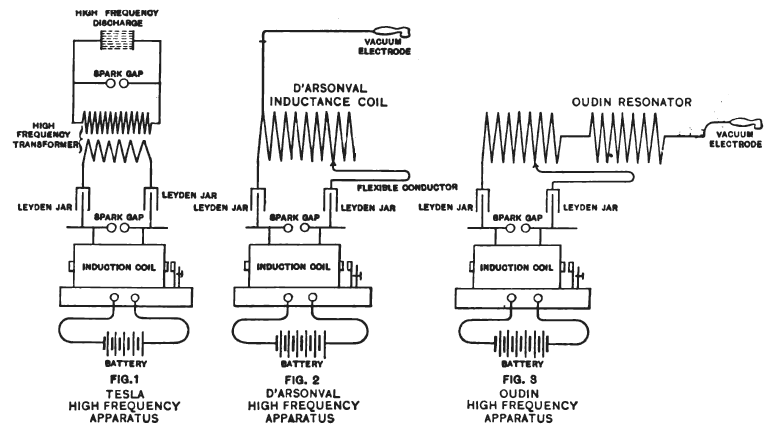Image: Tesla D'Arsonval and Oudin electrotherapy circuits
Description: The Tesla coil, D'Arsonval coil, and Oudin coil, three similar circuits widely used to produce high voltage, high frequency electricity that were applied to patients bodies in the obsolete medical field of Electrotherapy around the turn of the 20th century. In 1889, French physician and pioneering biophysicist Jacques Arsene D'Arsonval first experimented with applying high frequency alternating current to the body and documenting its effects, using circuit 2 above. He discovered that frequencies above 10 kHz did not cause the sensation of electric shock, and seemed to have beneficial effects. In 1891 Serbian-American inventor Nikola Tesla invented the Tesla coil, circuit 1, and experimented with passing hundreds of thousands of volts from it through his body. In 1893, French physician Paul Marie Oudin modified the D'Arsonval coil to produce higher voltage by adding a large series-driven "resonator" coil to it inventing the Oudin coil, circuit 3 above. By 1900 the three circuits, which produced radio frequency current at frequency of 100 kHz to 2 MHz, were widely used by doctors to treat a huge variety of medical conditions, and separate bodies of clinical practice grew up around "Tesla currents", "D'Arsonval currents", and "Oudin currents". The D'Arsonval coil, s simple spark-excited tuned circuit, produced relatively low voltage and high currents, around 20,000-30,000 volts and 100-500 mA, and was used for diathermy, deep heating of body tissues. The Tesla and Oudin coils produced extremely high voltages, 50,000 volts up to one million volts at low currents. The Tesla circuit used a resonant transformer, while the Oudin coil produced high voltage with a series-fed resonator coil which was not magnetically coupled to the other coil. In use, a pointed electrode was connected to the high voltage terminal of the Tesla or Oudin coil which produced luminous brush discharges (called "effluves"), and the doctor held the electrode (by an insulated handle) near the patient's body and played the sparks over the ailing body part. This treatment was not painful for the patient because the high frequency currents did not cause electric shock. Alternately, a "vacuum electrode" consisting of a metal electrode sealed inside a partially evacuated glass bulb was stroked over the ailing body part. This produced a dramatic violet glow while operating. Tesla apparatus was mostly used in the United States, while D'Arsonval and Oudin coils were used in Europe, although electrotherapy units manufactured for physicians often could generate all three types of current. Electrotherapy had its heyday around 1919 after World War 1 , but in the 1920s and 30s authorities began to crack down on fraudulent medical treatments and electrotherapy became obsolete by 1945. Alterations to image: Erased unnecessary excessive length of D'Arsonval coil so Oudin coil circuit diagram could be moved closer to the others to make the image more compact. Also erased a confusing dotted line from the D'Arsonval coil indicating a second electrode that was sometimes used in this circuit.
Title: Tesla D'Arsonval and Oudin electrotherapy circuits
Credit: Retrieved September 21, 2015 from Archie Frederick Collins, "An easily-made high frequency apparatus" in Scientific American Supplement, Munn and Co., New York, Vol. 63, No. 1618, January 5, 1907 p. 25929, fig. 1-3 on Google Books
Author: Archie Frederick Collins
Usage Terms: Public domain
License: Public domain
Attribution Required?: No
Image usage
The following page links to this image:


